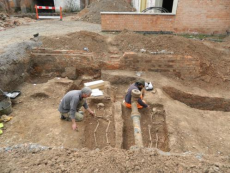
For hundreds of years British monarchs have been ceremonially buried with their graves most frequently lying in either Westminster Abbey or St George’s Chapel at Windsor castle. So you can imagine the public’s surprise when the body of King Richard III, ruler of England in the 15th century, was recently discovered in a car park!
Archaeologists from the University of Leicester along with Leicester City Council and the Richard III Society, joined forces in August this year to search for the remains of the former King and have recently found him buried beneath a car park in Leicester City Centre. This is an incredible discovery which plays an important part in the medieval history of Britain, especially as Richard of York was the last King of England to die on the battlefield.
Richard III was killed in the Battle of Bosworth Field in 1485 fighting against Henry Tudor, who went on to become King Henry VII. Following his death the body was stripped, as a form of humiliation, and carried on horseback to Leicester where he was buried in the town friary. Now, centuries later, that very friary lies beneath a modern car park and a dedicated team of researchers have uncovered an extraordinary piece of history.

Though this news is being widely celebrated amongst the academic community, the issue is now arising as to where Richard will be re-buried. Understandably, the researchers of the University of Leicester and the City Council were all set to bury the remains in Leicester Cathedral as that was the city where he was originally buried and because it was their excavation teams who found him. However, legal action has been brought by a group of Richard III’s descendants who feel that the body should be buried in York, as this was what they believe he would have wanted.
Though the new burial ground is yet to be decided there is still great excitement amongst the historical community at this incredibly important discovery. After years of research, the body of the last King of the North has been found and historians now have a crucial insight into the last battle of the War of the Roses.

0 Comment:
Be the first one to comment on this article.